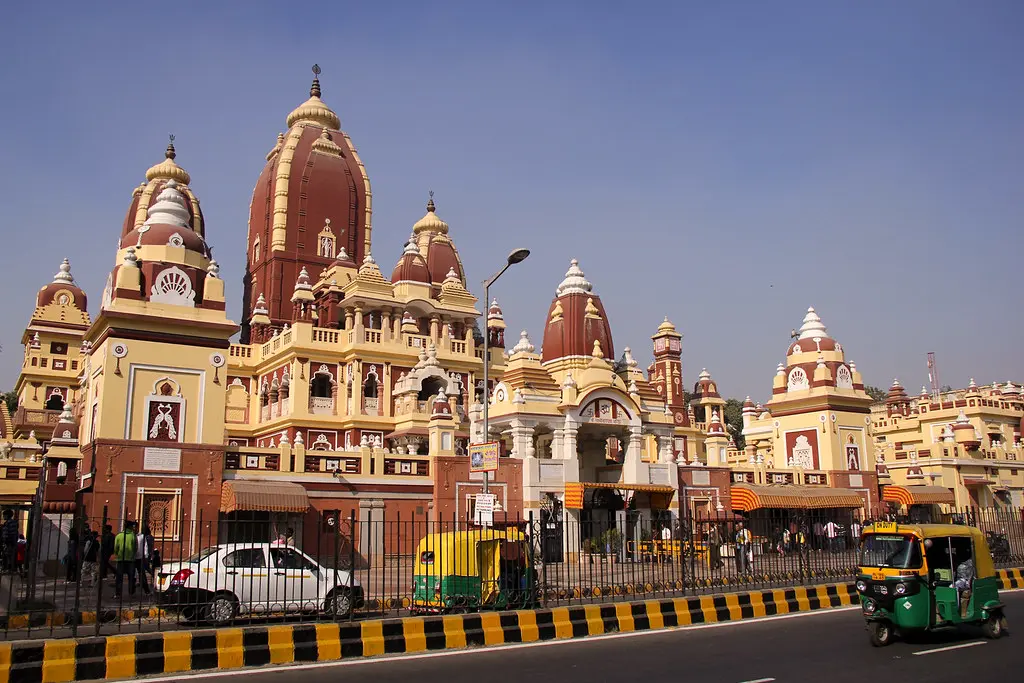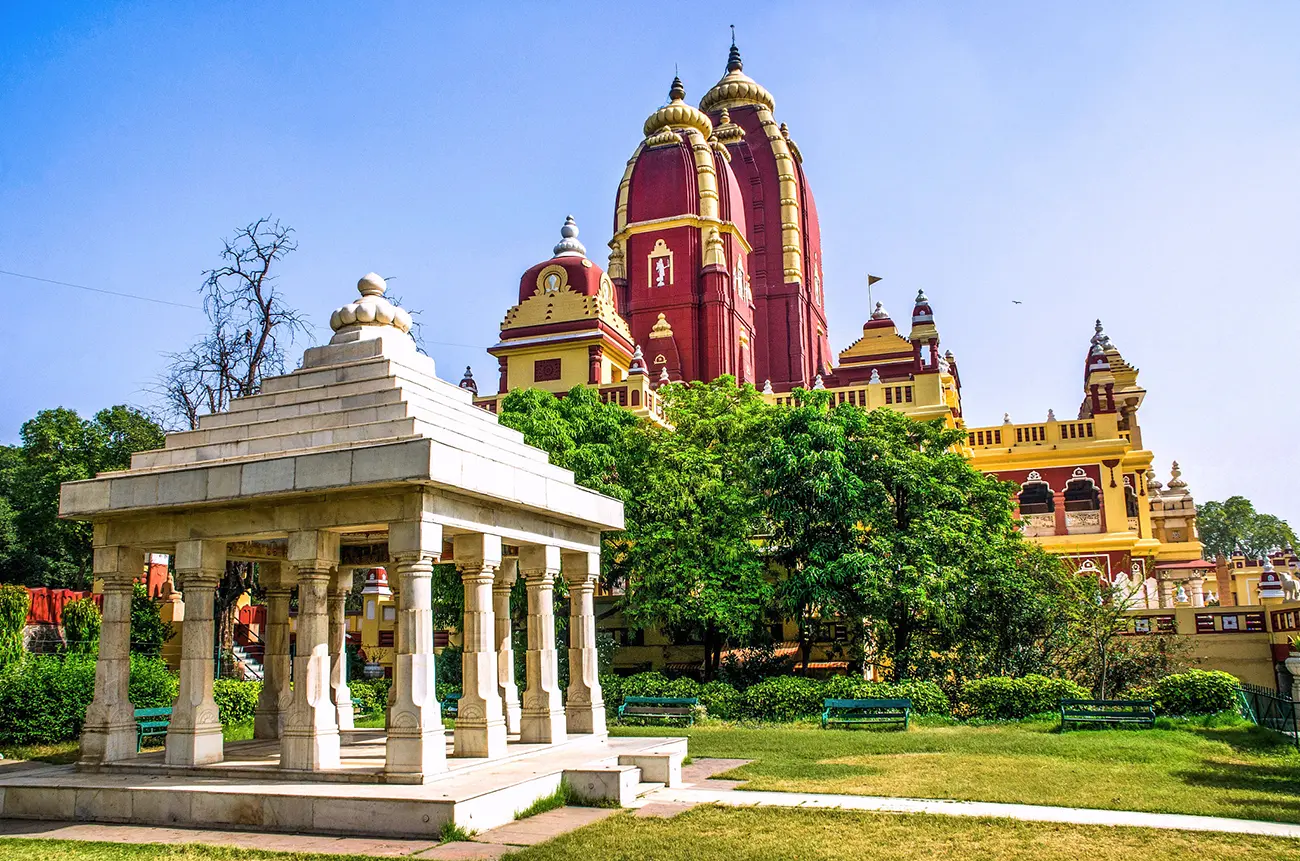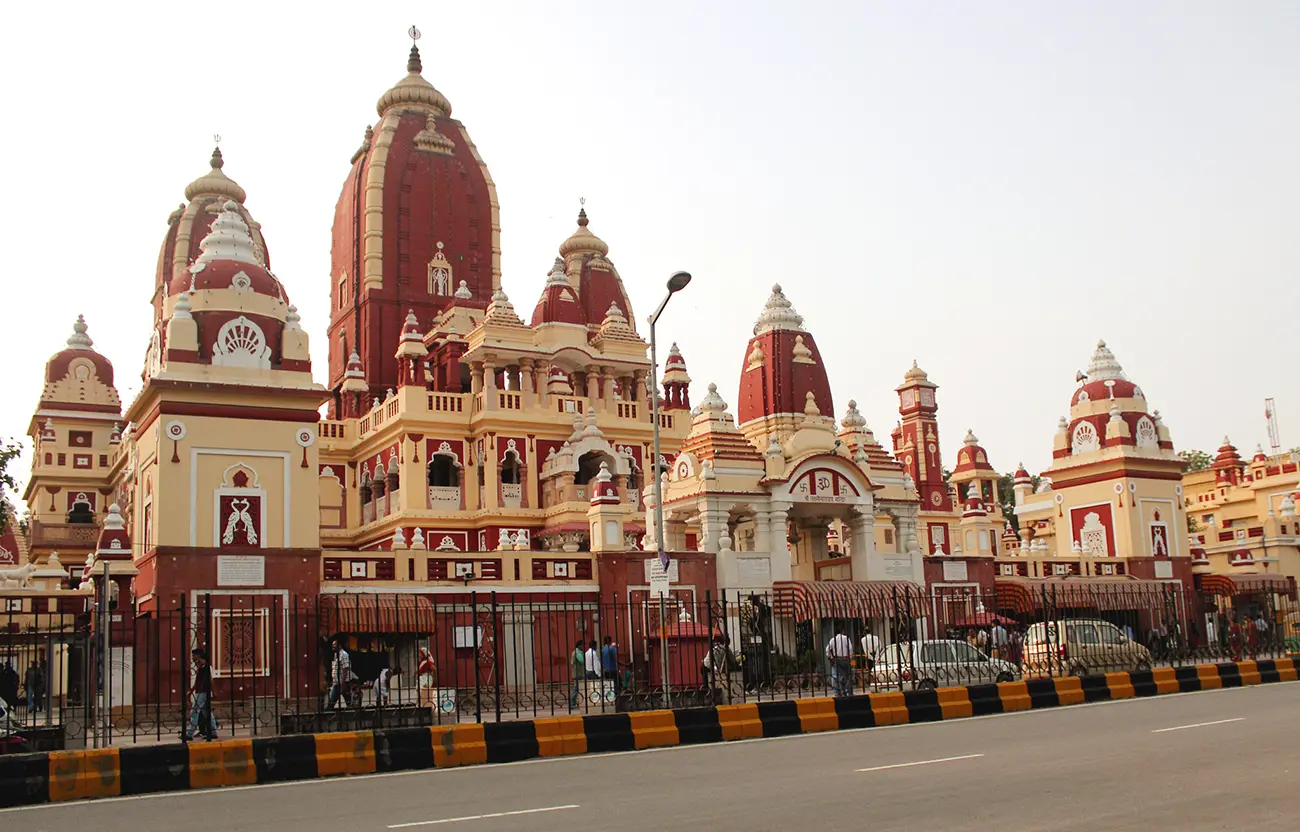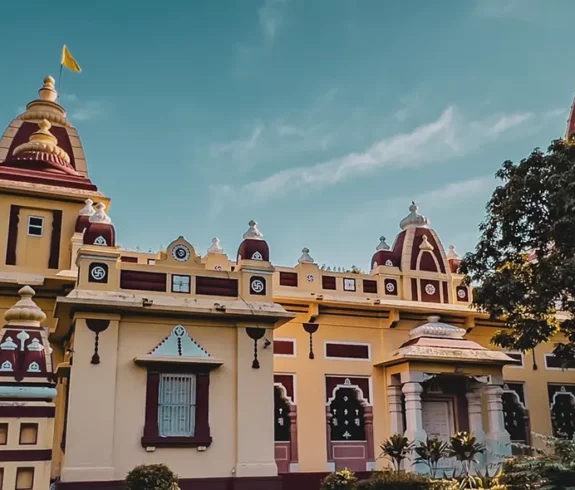Birla Temple, Delhi, also called the Lakshmi Narayan Temple, is a famous Hindu temple and a beloved spiritual landmark in India’s capital. Dedicated to Lord Narayan (Vishnu) and Goddess Lakshmi, it is a place to pray for blessings and prosperity. Many people also call it Birla Mandir after its founders. It is built of white marble and red sandstone, which gives it a bright, colorful appearance under the Delhi sky.
The temple is situated in the heart of New Delhi on Mandir Marg, near Gol Market and just west of the busy Connaught Place area. Its grand architecture and large, well-kept gardens and fountains stand out. Many people visit Birla Temple daily for prayer and peace, making it one of the city’s most important places of devotion. The temple is often seen as an oasis of calm in busy Delhi.
Many people and travel guides recommend Birla Temple as a must-see for its blend of art, history, and devotion. This was the first of several grand Lakshmi Narayan temples (Birla Mandirs) that the Birla family built in other cities across India.

Historical Context
In 1933, Maharaja Udaybhanu Singh of Jaipur laid the foundation stone for the temple. The Birla family funded and led the project. B. D. Birla (Baldeo Das Birla) and his son Jugal Kishore Birla provided the idea and money to build it. Construction took about six years, and the temple was finally completed in 1939. Skilled architects and artisans worked on its design, combining tradition with new techniques.
When the temple opened, it was a significant event. Mahatma Gandhi agreed to inaugurate the temple only under one condition: allowing people of all castes and backgrounds to enter and worship. At that time, many temples did not permit lower caste people inside. Gandhi made the Birla Temple a symbol of social equality by insisting on inclusivity.
The temple gained a reputation from the first ceremony for its open and welcoming spirit. This unique history gives Birla Temple a special place in Delhi’s story, highlighting unity and social progress. Gandhi’s presence at the opening gave the temple national fame and made it known nationwide.
Architecture and Design
Temple Structure and Materials
Birla Temple was constructed in the Nagara style of North Indian temple architecture. It covers about 7.5 acres of land and has three levels. The building combines red sandstone and white marble brought from Rajasthan. This two-color design makes the temple shine under the Delhi sky. Many parts of the temple, including the main statues, are carved from pure white marble. Other stones like the golden Jaisalmer and grey Kota were used for floors and walls.
Skilled artisans carved the temple’s stone for years, so carvings of Hindu gods, goddesses, and scenes from sacred stories appear on nearly every wall. The temple’s highest shikhara tower rises about 160 feet above the ground. The temple faces east, so it looks bright in the morning sun. The whole structure sits on a high platform (plinth), which gives it a grand appearance. Many small towers, domes, and carved spires decorate the roofline of the temple.
Shrines, Gardens, and Features
Inside the main temple hall are statues of Lord Narayan (Vishnu) and his consort, Goddess Lakshmi. These are the central idols of the temple. On both sides of this main shrine are smaller shrines. There is a shrine to Lord Shiva (the destroyer), one to Lord Ganesha (the remover of obstacles), and one to Lord Hanuman (the monkey god).
A temple honoring Goddess Durga, the divine warrior, stands alongside a shrine dedicated to Lord Buddha. Each of these deities has its own carved stone idol for worship. In addition, near the temple entrance, there is a small shrine dedicated to Sai Baba, a 19th-century saint. Many devotees stop there to offer coins and flowers and ask for his blessings.
Visitors will see the main prayer hall’s polished marble floors and brass bells. A giant brass bell sits on the floor near the main idols, and worshippers sometimes ring it during prayer. A decorative chandelier hangs from the ceiling above. The walls are etched with images of gods and Sanskrit verses from scriptures.
Some of the ceiling carvings even have stone elephants or other animals. Pigeons fly freely in this open hall, which many people find charming. The hall’s floor also contains a large white marble globe. It symbolizes Lord Narayan’s role as protector of the whole world.

The temple compound has beautiful gardens all around. The gardens have green lawns, colorful flower beds, and shady trees—walkways of polished stone lead through the green space. Fountains, water channels, and small waterfalls flow peacefully, and the flowing water echoes softly.
In the evening, lights shine on the fountains and illuminate the temple walls. Large stone sculptures and pillars, showing scenes from Indian culture and religion, decorate the gardens and pathways. The gardens also have benches and shaded spots for visitors to sit and enjoy the view.
On the temple’s north side stands the Geeta Bhawan, a special hall for gatherings and readings. Inside this hall, murals on the walls depict scenes from the Mahabharata and verses from the Bhagavad Gita. People come here for lectures and scripture study.
One unique feature is an artificial hill with a waterfall. Built of rocks and stone, the water flows like a natural stream. Visitors often stand near this waterfall or take photos of it. The temple’s mix of carved stone, green gardens, and water features gives it a peaceful, oasis-like feel.
Visitor Experience
Atmosphere and Rituals
Many visitors say that Birla Temple feels calm and serene. In the early morning light, the temple spires glow warmly in the dawn. At that time, there are usually only a few people. You may hear bells ringing as priests open the doors and clean the shrine. Incense smoke gently rises at the shrines. Some visitors sit quietly on the steps or garden benches and pray.
At dawn, you might join a short morning aarti. Chances are lit before the deity during this ritual, and a priest chants prayers. The mood feels peaceful as the city wakes up around the temple. Many local people like to do the morning prayers for a calm start to the day.
The temple holds another meaningful aarti ceremony in the late afternoon or early evening, usually around sunset. The sanctuary is adorned with vibrant blooms and glowing lanterns for the evening ceremony. Priests chant prayers and move lamps before the idols, and worshippers sing and clap along. This brings a warm and uplifting feeling to everyone. Even if you do not join in praying, watching the evening aarti can be a touching experience.
Throughout the day, the temple complex remains peaceful. Inside the main hall, visitors speak in soft tones. People often bring flower garlands or sweets (prasadam) for the deities. Making a small donation or placing flowers at the shrine is common. The priest may then give you a colored tilak (mark) on your forehead as a blessing. You will see people of all ages and backgrounds here. The sound of flowing water from the fountains and recorded devotional music adds to the gentle atmosphere.
Festivals and Celebrations
Birla Temple attracts many visitors during Hindu festivals. Deepavali, the celebration of light, holds great importance in this region. On Diwali, the temple is decorated with thousands of little oil lamps and electric lights, and colorful rangoli patterns cover the floors. The air is filled with the smell of marigolds and jasmine. At night, the whole temple shines brightly, and many people come to pray for good fortune. There may also be special musical programs in the evening.
Krishna Janmashtami, celebrating Lord Krishna’s birth, is a major festivity at the Birla Mandir. On this day, many people gather late at night for prayers. The temple bells ring at midnight, and priests perform a special ritual for baby Krishna. Worshippers present offerings of candies, fresh fruits, and dairy to the idol of Lord Krishna. The crowd sings devotional songs (bhajans) and sometimes dances. The atmosphere on Janmashtami is joyful and lively.
Other festivals like Holi (the festival of colors) and Navratri (worship of the goddess Durga) are also celebrated here. The spring festival of Ram Navami (birth of Lord Rama) is also observed with special prayers. The temple is decorated with flowers, and extra prayers are held during these events. On festival days, you will see more people than usual, and you might notice special stalls selling flower petals, sweets, and incense outside.
For a quiet visit, the recommended times are early morning (around 6–8 AM) or late afternoon to evening (around 5–7 PM). These hours are calmer and less crowded. Early morning lets you enjoy the sunrise over the temple, and evening lets you feel the quiet end of the day.
Weekends and holidays can be busy with local families, so visiting on a weekday can give a more peaceful experience. Also, note that Delhi’s summer months (April–June) can be very hot, so if you visit in summer, try to come early or later in the evening to avoid the midday heat.
Visitor Etiquette
When visiting Birla Temple, following some simple rules of respect is essential. There is a shoe stand at the entrance where visitors leave their sandals. You pay a small fee (a few rupees) to the attendant, who will keep them safe until you leave.
Dress modestly. Both men and women should cover their shoulders and knees. Avoid wearing shorts or sleeveless shirts inside the temple. Some women carry a scarf to cover their heads, though it is not required. The idea is to show respect as you would in any sacred place.
Inside the main prayer hall, avoid taking photos or videos. Photography is generally not allowed in the inner sanctum of the temple. Look for signs that say “No Photography.” You may take pictures outside, in the gardens, or of the temple structure. If you have a camera or phone, switch it off or put it in your bag inside the hall.
Speak quietly and move slowly. This is a place of prayer and reflection. If an aarti ceremony occurs, stand or sit at a respectful distance and watch quietly. You can join in by clapping your hands or folding them in prayer when others do. Do not push or disturb people who are praying or meditating.
If you bring young children, keep an eye on them near the fountains and steps, which can be slippery. There are benches in the garden where families often rest. You may buy fresh flowers, coconuts, or incense sticks from the stalls near the entrance to offer at the shrine. This is a common tradition, but not mandatory. If you offer something, a priest may then give you a blessing. Whether or not you bring an offering, feel free to bow or sit quietly and enjoy the peaceful atmosphere.
Why Visit Birla Temple
Birla Temple in Delhi offers a unique mix of spiritual, cultural, and architectural experiences. The temple is a significant part of the city’s heritage and history. Learning about its open-door policy helps you see an essential side of India’s journey toward equality. Even a simple temple tour tells a story of unity and social progress.
The temple’s design is itself a reason to visit. It features white marble domes, red sandstone walls, and detailed carvings. Many scenes from the Hindu epics are carved on the walls and pillars. Photographers will enjoy capturing the colorful temple under the clear blue sky. The play of light and shadow in the early morning or late afternoon makes the temple beautiful to photograph. For anyone who loves art and history, the temple offers a chance to admire fine craftsmanship and Indian art.

Another reason to come is the quiet peace of the temple gardens. New Delhi can be hectic, but the air is cool and still inside the Birla Temple grounds. Many visitors feel rested after sitting by the fountains or walking under the trees. This calm, green spot is a welcome break during a busy sightseeing trip.
The temple is also easy to include on a city tour day. It is near major spots like Connaught Place and Jantar Mantar. After visiting Birla Temple, you can easily walk to these places. This makes it a convenient stop for tourists. Security and maintenance are generally good, making families and solo travelers safe. Overall, Birla Temple offers a quiet, inspiring break for any visitor in the middle of bustling Delhi.
Practical Information
- Location: Mandir Marg, near Gol Market, New Delhi 110001 (west of Connaught Place and close to Jantar Mantar and Agrasen Ki Baoli).
- How to Get There: The nearest metro station is R.K. Ashram Marg (Blue Line), about 1 km away. It is also easy to reach by auto-rickshaw or taxi from Connaught Place, Karol Bagh, Khan Market, or other central areas. Several city buses stop on Mandir Marg in front of the temple. If driving, street parking is available, or a small paid parking lot is nearby.
- Entry Fee: Free for all visitors.
- Opening Hours: Daily from 4:30 AM – 13:30 PM and 14:30 – 21:00 (local time). (Closed for one hour in the early afternoon.)
- Footwear Stand: Yes, a shoe stand is provided at the entrance. Visitors should leave their shoes or sandals there before entering the temple and collect them when they leave. The attendant collects a small fee.
- Lockers: Coin-operated lockers are available near the entrance for storing valuables like cameras or phones during your visit.
- Facilities: The temple has restrooms and drinking water facilities. Small stalls near the entrance sell fresh flowers, incense sticks, and other puja items. The garden grounds have benches and shaded spots for resting after darshan.
